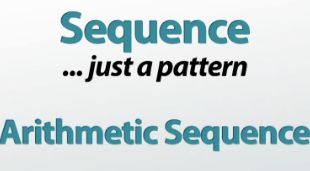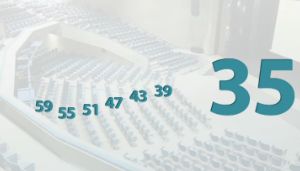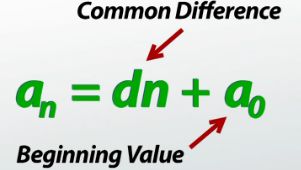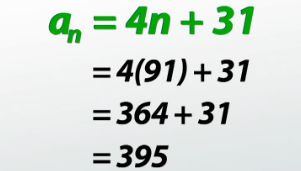How to Find and Classify an Arithmetic Sequence
After you watch the video and know the material, click HERE for the quiz.
Arithmetic sequences are everywhere, and with a few tricks you learn here, you could end up looking like a psychic the next time you go to a movie or a football game!
The Arithmetic Sequence of Stadium Seating
A sequence is just a pattern, and an arithmetic sequence is one that is generated through repeated addition. So each term in the sequence is created by adding the same thing to the last one, over and over again. For example, we could get the finite arithmetic sequence 11, 13, 15, 17, 19 simply by starting with 11 and adding 2 four times. Or maybe we could start with 30 and repeatedly add -10 to get the infinite arithmetic sequence 30, 20, 10, 0, -10… and on and on and on.
 |
 |
Describing this sequence in words is good enough for now, and can help us answer questions like, how many seats are in the 10th row? Well okay, lets see, if we can just continue the pattern, that would mean that there are 55 in the 6th, 59 in the 7th, then 63 in the 8th, 67... finally, 71 seats in the 10th row.
But if it turns out that we're in the University of Michigan Stadium, which has close to 100 rows of seats, would the words and pattern really help us figure out how many seats were in the 91st row? Not so much. Not only would this be incredibly tedious, but there's also a good chance we'd end up making a small mistake and our answer would be off by a few seats.
What we really need is a formula that we can just plug 91 into and it'll spit out exactly how many seats are in that row for us. The way we can do that is by noticing that an arithmetic sequence is really a linear relationship. Our current example, 35, 39, 43, 47… this is linear because it is increasing by the same amount each step, in this case, 4.
Creating the Formula of an Arithmetic Sequence
If we were going to write this as a linear equation, we'd probably end up using slope-intercept form: y=mx+b. Remember that m tells us the slope, or how much it moves by, and b is the y-intercept, or where it begins when x is equal to 0.
These two things are fairly straightforward to find in our pattern; the slope in this case (how much it's moving by) is simply 4. We keep on adding 4 each time so in our equation where we see m, we put a 4. The b (where it begins or the y-intercept), is a little more complicated because you have to realize that this is where x equals 0, and our first term is exactly that - the first term, a1. We need a0, which means that we do have to go backwards one entry; to go backwards we don't add 4, but we subtract 4. It looks like if there was one row closer it would have 31 seats, which means my b value - my y-intercept - is 31. I get the equation y = 4x+31.
 |
Now because we're treating this as a sequence, while our rule will stay the same, we're going to use different letters to write the rule. In the place of y, we're going to put a subscript n, which will stand for the nth term, and in place of x we'll put n. So if I want the twelfth term, I can plug 12 in for n.
Two Standard Formulas of Arithmetic Sequences
This brings us the rule for the nth row of our stadium as an = 4n+31. All arithmetic rules will look something like this and they will be an = dn+a0. The a0 obviously represents the beginning value, kind of like the b or the y-intercept, and d(what used to be called the slope) is now going to be called the common difference because each term in our sequence has a common difference between them.
 |
Now there is another way of writing this formula that you often see. Instead of saying an = dn+a0, you can also say an = d(n-1)+a1. This does make it slightly easier because you don't have to work backwards to find a0, but I find that it's easier to remember the one with a0 because it's so similar to the mx+b. It makes more sense to me, but you are welcome to use the second one and a lot of text books in other classes will use this one. As an example, if we were to write the nth row formula this way, it would be an = 4(n-1)+35.
Okay so now that we have the rule for whatever row of our stadium that we want, finding the 91st row is really easy; we don't have to make that list any more, all we have to do is take our rule and instead of wanting the nth row, we want the 91st row. This means that where n used to be in our equation, we put 91. I do 4 times 91, I get 364, I add on 31 and it turns out that the 91st row in Michigan Stadium would have 395 seats.
 |
Finding an Arithmetic Sequence Using Terms
Once we get really good, we can even come up with the rule for the nth term simply given any two random terms of a sequence. Let's say that the fifth term is 22 and the twelfth term is 64. If we're asked for the rule of the nth term, I like drawing out what we know so I get a visual of what I'm looking at. I don't know the first term or the second term or the third term or the fourth, but I do know that the fifth is 22; I don't know the sixth the seventh...but I do know that the twelfth is 64. So because this is an arithmetic sequence, we're going up by the same amount each step, and apparently in 7 steps, going from the fifth down to the twelfth, I go up 42 points. That means I can do a quick division problem to tell me that if it takes me 7 steps to go up 42, I must be going up 6 each step, which would make my common difference 6. We can check this really quickly just by filling in our chart - 28, 34, 40, 46, 52, 58, and sure enough, 64. So we're good.
The only other thing I need from my rule is my beginning value, the a0. I can simply find this by working my way backwards; instead of adding 6, going backwards would mean subtract 6. So back 6 again, again, again, again, and I end up back at -8 as a0. I can also do a shortcut and say I'm going backwards 5 steps. Backwards 5 steps would mean a total backwards of -30; if I go backwards -30 from 22, again, I end up back at -8. Therefore, our rule for the nth term is an = 6d-8. Or, using the alternate form with a1 instead of 0, it would only go back 4 steps, and therefore our rule would be an = 6(n-1)-2.
Lesson Summary
To review: arithmetic formulas are patterns generated by repeated addition and are similar to linear equations. Because they're similar to linear equations, the rule is very similar to y=mx+b and it is an = nd+a0, where d is the common difference. This rule can help us draw conclusions about terms that are far away from the beginning of the sequence.